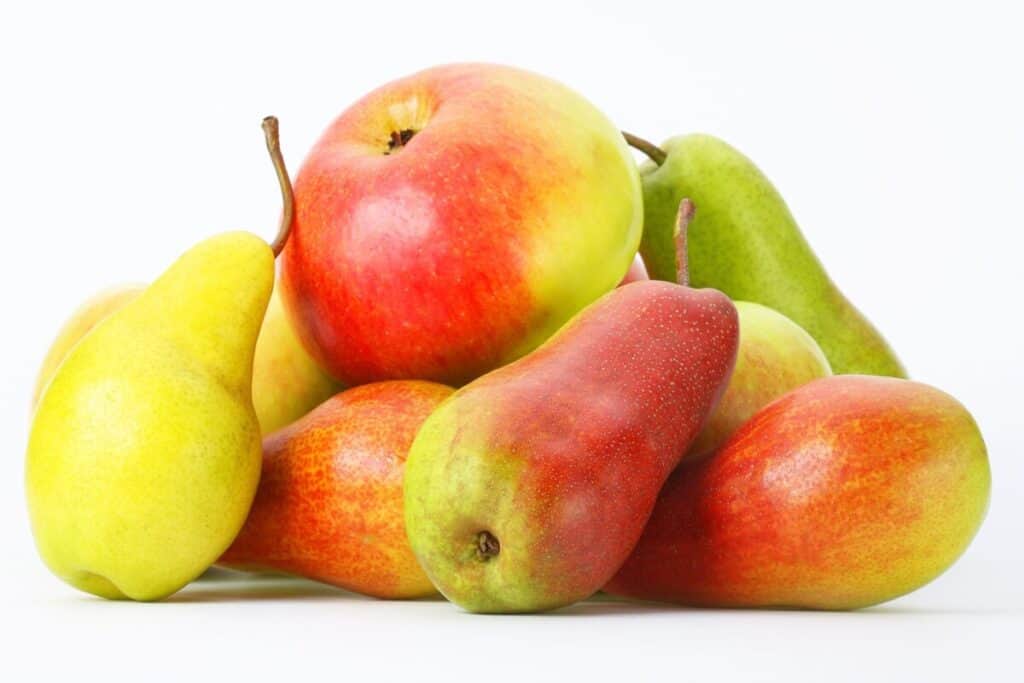
When Fall rolls around, your local grocery store will likely carry more varieties of pears, and they will be at their peak of deliciousness. But how do you know which one to choose? Here is your guide to which pear variety is the sweetest; which is healthiest; and which types are best for eating raw or for cooking.
Sweetest Pear Variety
As you can see from the comparison chart below, Bosc is the sweetest variety of pear, and Asian is the least sweet. You may notice the relatively less sweet taste of an Asian pear, but otherwise, the other types of pears will likely taste comparable to each other when it comes to sweetness.
| Variety | Total Sugars (grams) |
| Anjou (green) | 9.73 |
| Anjou (red) | 9.54 |
| Asian | 7.05 |
| Bartlett | 9.69 |
| Bosc | 10.23 |
Most Nutritious Pear Variety
The good news is all pear types are nutrition powerhouses. The nutrient profiles of the different pear types vary only slightly. All pears are good sources of fiber, copper, vitamin C, vitamin K, phosphorous, and lutein/zeaxanthin (these latter two help protect eye health). The crispy Asian pear has an edge when it comes to fiber. See how the types compare in the table below.
| Variety | Fiber (grams) | Copper (mg) | Phosphorous (mg) | Potassium (mg) | Vitamin C (mg) | Vitamin K (µg) | Lutein/ Zeaxanthin (µg) |
| Anjou (green) | 3.1 | 0.077 | 13 | 127 | 4.4 | 4.3 | 46 |
| Anjou (red) | 3 | 0.07 | 13 | 123 | 5.2 | 0 | 53 |
| Asian | 3.6 | 0.05 | 11 | 121 | 3.8 | 4.5 | 50 |
| Bartlett | 3.1 | 0.078 | 11 | 101 | 4.4 | 3.8 | 51 |
| Bosc | 3.1 | 0.104 | 14 | 122 | 2.8 | 5.2 |
But these aren’t the only nutrients found in pears. The biggest benefit of pears may be their phytonutrient content. Phytonutrients are plant chemicals that can help protect us from illness. Flavonoids in pears, and the anthocyanins found in red-skinned varieties, all help improve insulin sensitivity.
The special fibers in pears have also been associated with improving heart disease and warding off colon, stomach and esophageal cancers. Pears are a great source of pectin, which is a type of soluble fiber that nourishes healthy gut bacteria
Which Pear Types to Eat Raw or Cook?
All pear types are good to eat raw. The Asian pear is more apple-like than other pears, crunchy and slightly less sweet; but no less delicious than its tasty pear cousins. Bartlett pears are the softest and will fall part the quickest. So the Anjou and Bosc varieties stand up best in salads and are best for making poached pears, where you want the fruit’s shape to hold.
Buy Organic
A final note: buy organic pears if possible. Pears are on the EWG’s “dirty dozen” list, and have a tendency to absorb higher amounts of pesticides that are harder to wash off, with its porous peel. If you can’t buy organic, then I recommend peeling pears, in spite of the loss of nutrients and fiber. The white flesh is still highly nutritious.
What’s the healthiest apple? There is a definitive answer based on current research. Click here.
Are beans low in carbs? Get the full story here.
When is it safe to eat the skin on fresh produce? Find out here.
Want more energy? Get 10 surprising tips here.
Resources
- USDA FoodData Central: https://fdc.nal.usda.gov/fdc-app.html#/?query=bartlett%20pear.
- https://www.ewg.org/foodnews/dirty-dozen.php.
- Brahem, M., Renard, C. M., Eder, S., Loonis, M., Ouni, R., Mars, M., & Le Bourvellec, C. (2017). Characterization and quantification of fruit phenolic compounds of European and Tunisian pear cultivars. Food research international (Ottawa, Ont.), 95, 125–133. https://doi.org/10.1016/j.foodres.2017.03.002.
- Lila M. A. (2004). Anthocyanins and Human Health: An In Vitro Investigative Approach. Journal of biomedicine & biotechnology, 2004(5), 306–313. https://doi.org/10.1155/S111072430440401X/.
- Bernstein P.S., Li B., Vachali P.P., Gorusupudi A., Shyam R., Henriksen B.S., Nolan J.M. Lutein, zeaxanthin, and meso-zeaxanthin: The basic and clinical science underlying carotenoid-based nutritional interventions against ocular disease. Prog. Retin. Eye Res. 2016;50:34–66. https://doi.org/10.1016/j.preteyeres.2015.10.003.
- Maras, J. E., Talegawkar, S. A., Qiao, N., Lyle, B., Ferrucci, L., & Tucker, K. L. (2011). Flavonoid intakes in the Baltimore Longitudinal Study of Aging. Journal of food composition and analysis : an official publication of the United Nations University, International Network of Food Data Systems, 24(8), 1103–1109. https://doi.org/10.1016/j.jfca.2011.04.007.
- Maras, J. E., Talegawkar, S. A., Qiao, N., Lyle, B., Ferrucci, L., & Tucker, K. L. (2011). Flavonoid intakes in the Baltimore Longitudinal Study of Aging. Journal of food composition and analysis : an official publication of the United Nations University, International Network of Food Data Systems, 24(8), 1103–1109. https://doi.org/10.1016/j.jfca.2011.04.007.
- Xu, H., Luo, J., Huang, J., & Wen, Q. (2018). Flavonoids intake and risk of type 2 diabetes mellitus: A meta-analysis of prospective cohort studies. Medicine, 97(19), e0686. https://doi.org/10.1097/MD.0000000000010686.
- Peterson, J. J., Dwyer, J. T., Jacques, P. F., & McCullough, M. L. (2012). Associations between flavonoids and cardiovascular disease incidence or mortality in European and US populations. Nutrition reviews, 70(9), 491–508. https://doi.org/10.1111/j.1753-4887.2012.00508.x.
- Li, X., Zhang, J. Y., Gao, W. Y., Wang, Y., Wang, H. Y., Cao, J. G., & Huang, L. Q. (2012). Chemical composition and anti-inflammatory and antioxidant activities of eight pear cultivars. Journal of agricultural and food chemistry, 60(35), 8738–8744. https://doi.org/10.1021/jf303235h.
- Oude Griep, L. M., Verschuren, W. M., Kromhout, D., Ocké, M. C., & Geleijnse, J. M. (2011). Colors of fruit and vegetables and 10-year incidence of stroke. Stroke, 42(11), 3190–3195. https://doi.org/10.1161/STROKEAHA.110.611152.
